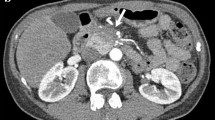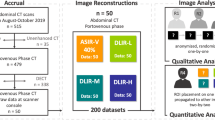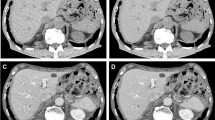Abstract
Objective
To demonstrate the clinical advantages of a deep-learning image reconstruction (DLIR) in low-dose dual-energy computed tomography enterography (DECTE) by comparing images with standard-dose adaptive iterative reconstruction-Veo (ASIR-V) images.
Methods
In this Institutional review board approved prospective study, 86 participants who underwent DECTE were enrolled. The early-enteric phase scan was performed using standard-dose (noise index: 8) and images were reconstructed at 5 mm and 1.25 mm slice thickness with ASIR-V at a level of 40% (ASIR-V40%). The late-enteric phase scan used low-dose (noise index: 12) and images were reconstructed at 1.25 mm slice thickness with ASIR-V40%, and DLIR at medium (DLIR-M) and high (DLIR-H). The 70 keV monochromatic images were used for image comparison and analysis. For objective assessment, image noise, artifact index, SNR and CNR were measured. For subjective assessment, subjective noise, image contrast, bowel wall sharpness, mesenteric vessel clarity, and small structure visibility were scored by two radiologists blindly. Radiation dose was compared between the early- and late-enteric phases.
Results
Radiation dose was reduced by 50% in the late-enteric phase [(6.31 ± 1.67) mSv] compared with the early-enteric phase [(3.01 ± 1.09) mSv]. For the 1.25 mm images, DLIR-M and DLIR-H significantly improved both objective and subjective image quality compared to those with ASIR-V40%. The low-dose 1.25 mm DLIR-H images had similar image noise, SNR, CNR values as the standard-dose 5 mm ASIR-V40% images, but significantly higher scores in image contrast [5(5–5), P < 0.05], bowel wall sharpness [5(5–5), P < 0.05], mesenteric vessel clarity [5(5–5), P < 0.05] and small structure visibility [5(5–5), P < 0.05].
Conclusions
DLIR significantly reduces image noise at the same slice thickness, but significantly improves spatial resolution and lesion conspicuity with thinner slice thickness in DECTE, compared to conventional ASIR-V40% 5 mm images, all while providing 50% radiation dose reduction.



Similar content being viewed by others
References
Deepak, P., et al., Radiological Response Is Associated With Better Long-Term Outcomes and Is a Potential Treatment Target in Patients With Small Bowel Crohn's Disease. Am J Gastroenterol, 2016. 111(7): p. 997-1006.
Yadav, J., et al., Butorphanol in Labour Analgesia. JNMA; journal of the Nepal Medical Association, 2018. 56(214): p. 940-944.
Zhong, J., et al., Evaluation of Image Quality and Detectability of Deep Learning Image Reconstruction (DLIR) Algorithm in Single- and Dual-energy CT. J Digit Imaging, 2023. 36(4): p. 1390-1407.
Kim, I., et al., Deep learning-based image reconstruction for brain CT: improved image quality compared with adaptive statistical iterative reconstruction-Veo (ASIR-V). Neuroradiology, 2021. 63(6): p. 905-912.
Pelt, D.M. and K.J. Batenburg, Improving filtered backprojection reconstruction by data-dependent filtering. IEEE Trans Image Process, 2014. 23(11): p. 4750-62.
Jensen, C.T., et al., Image Quality Assessment of Abdominal CT by Use of New Deep Learning Image Reconstruction: Initial Experience. AJR Am J Roentgenol, 2020. 215(1): p. 50-57.
Patino, M., et al., Iterative Reconstruction Techniques in Abdominopelvic CT: Technical Concepts and Clinical Implementation. AJR Am J Roentgenol, 2015. 205(1): p. W19-31.
Jensen, C.T., et al., Detection of Colorectal Hepatic Metastases Is Superior at Standard Radiation Dose CT versus Reduced Dose CT. Radiology, 2019. 290(2): p. 400-409.
Goodenberger, M.H., et al., Computed Tomography Image Quality Evaluation of a New Iterative Reconstruction Algorithm in the Abdomen (Adaptive Statistical Iterative Reconstruction-V) a Comparison With Model-Based Iterative Reconstruction, Adaptive Statistical Iterative Reconstruction, and Filtered Back Projection Reconstructions. J Comput Assist Tomogr, 2018. 42(2): p. 184-190.
Telesmanich, M.E., et al., Third version of vendor-specific model-based iterativereconstruction (Veo 3.0): evaluation of CT image quality in the abdomen using new noise reduction presets and varied slice optimization. Br J Radiol, 2017. 90(1077): p. 20170188.
Samei, E. and S. Richard, Assessment of the dose reduction potential of a model-based iterative reconstruction algorithm using a task-based performance metrology. Med Phys, 2015. 42(1): p. 314-23.
Geyer, L.L., et al., State of the Art: Iterative CT Reconstruction Techniques. Radiology, 2015. 276(2): p. 339-57.
Parakh, A., et al., Sinogram-based deep learning image reconstruction technique in abdominal CT: image quality considerations. Eur Radiol, 2021. 31(11): p. 8342-8353.
Nam, J.G., et al., Image quality of ultralow-dose chest CT using deep learning techniques: potential superiority of vendor-agnostic post-processing over vendor-specific techniques. Eur Radiol, 2021. 31(7): p. 5139-5147.
Nam, J.G., et al., Deep learning reconstruction for contrast-enhanced CT of the upper abdomen: similar image quality with lower radiation dose in direct comparison with iterative reconstruction. Eur Radiol, 2021. 31(8): p. 5533-5543.
Noda, Y., et al., Deep learning image reconstruction for pancreatic low-dose computed tomography: comparison with hybrid iterative reconstruction. Abdom Radiol (NY), 2021. 46(9): p. 4238-4244.
Akagi, M., et al., Deep learning reconstruction improves image quality of abdominal ultra-high-resolution CT. Eur Radiol, 2019. 29(11): p. 6163-6171.
Radmard, A.R., et al., Mesenteric lymph nodes in MR enterography: are they reliable followers of bowel in active Crohn's disease? Eur Radiol, 2018. 28(10): p. 4429-4437.
Potretzke, T.A., et al., Early small-bowel ischemia: dual-energy CT improves conspicuity compared with conventional CT in a swine model. Radiology, 2015. 275(1): p. 119-26.
Cao, L., et al., Improving spatial resolution and diagnostic confidence with thinner slice and deep learning image reconstruction in contrast-enhanced abdominal CT. Eur Radiol, 2023. 33(3): p. 1603-1611.
Verdun, F.R., et al., Image quality in CT: From physical measurements to model observers. Phys Med, 2015. 31(8): p. 823-843.
Brady, S.L., et al., Improving Image Quality and Reducing Radiation Dose for Pediatric CT by Using Deep Learning Reconstruction. Radiology, 2021. 298(1): p. 180-188.
Jiang, J.M., et al., The Value of Deep Learning Image Reconstruction in Improving the Quality of Low-Dose Chest CT Images. Diagnostics (Basel), 2022. 12(10).
Cao, L., et al., A study of using a deep learning image reconstruction to improve the image quality of extremely low-dose contrast-enhanced abdominal CT for patients with hepatic lesions. Br J Radiol, 2021. 94(1118): p. 20201086.
Oostveen, L.J., et al., Deep learning-based reconstruction may improve non-contrast cerebral CT imaging compared to other current reconstruction algorithms. Eur Radiol, 2021. 31(8): p. 5498-5506.
Liu, P., et al., Impact of Deep Learning-based Optimization Algorithm on Image Quality of Low-dose Coronary CT Angiography with Noise Reduction: A Prospective Study. Acad Radiol, 2020. 27(9): p. 1241-1248.
Wang, X., et al., Comparison of image quality and lesion diagnosis in abdominopelvic unenhanced CT between reduced-dose CT using deep learning post-processing and standard-dose CT using iterative reconstruction: A prospective study. Eur J Radiol, 2021. 139: p. 109735.
Smith, J.T., et al., Effect of slice thickness on liver lesion detection and characterisation by multidetector CT. J Med Imaging Radiat Oncol, 2010. 54(3): p. 188-93.
Schaller, F., et al., Noise Reduction in Abdominal Computed Tomography Applying Iterative Reconstruction (ADMIRE). Acad Radiol, 2016. 23(10): p. 1230-8.
Khawaja, R.D., et al., Dose reduction in pediatric abdominal CT: use of iterative reconstruction techniques across different CT platforms. Pediatr Radiol, 2015. 45(7): p. 1046-55.
Singh, R., et al., Image Quality and Lesion Detection on Deep Learning Reconstruction and Iterative Reconstruction of Submillisievert Chest and Abdominal CT. AJR Am J Roentgenol, 2020. 214(3): p. 566-573.
Lee, Y.J., et al., Image quality and diagnostic accuracy of reduced-dose computed tomography enterography with model-based iterative reconstruction in pediatric Crohn's disease patients. Sci Rep, 2022. 12(1): p. 2147.
Author information
Authors and Affiliations
Contributions
Xu Lin: the acquisition of data, analysis of data, and drafting the article. Yankun Gao: the acquisition of data, analysis of data. Chao Zhu: the acquisition of data. Jian Song: the acquisition of data. Ling Liu: the analysis and interpretation of data. Jianying Li: the analysis and interpretation of data. Xingwang Wu: final approval of the version to be submitted.
Corresponding author
Additional information
Publisher's Note
Springer Nature remains neutral with regard to jurisdictional claims in published maps and institutional affiliations.
Supplementary Information
Below is the link to the electronic supplementary material.
Rights and permissions
Springer Nature or its licensor (e.g. a society or other partner) holds exclusive rights to this article under a publishing agreement with the author(s) or other rightsholder(s); author self-archiving of the accepted manuscript version of this article is solely governed by the terms of such publishing agreement and applicable law.
About this article
Cite this article
Lin, X., Gao, Y., Zhu, C. et al. Improved overall image quality in low-dose dual-energy computed tomography enterography using deep-learning image reconstruction. Abdom Radiol (2024). https://doi.org/10.1007/s00261-024-04221-y
Received:
Revised:
Accepted:
Published:
DOI: https://doi.org/10.1007/s00261-024-04221-y




